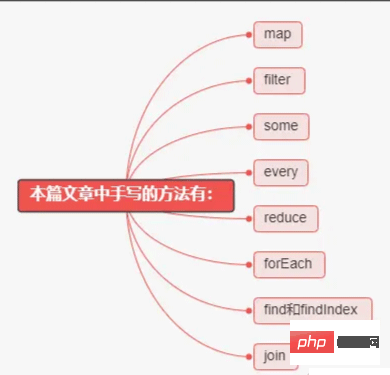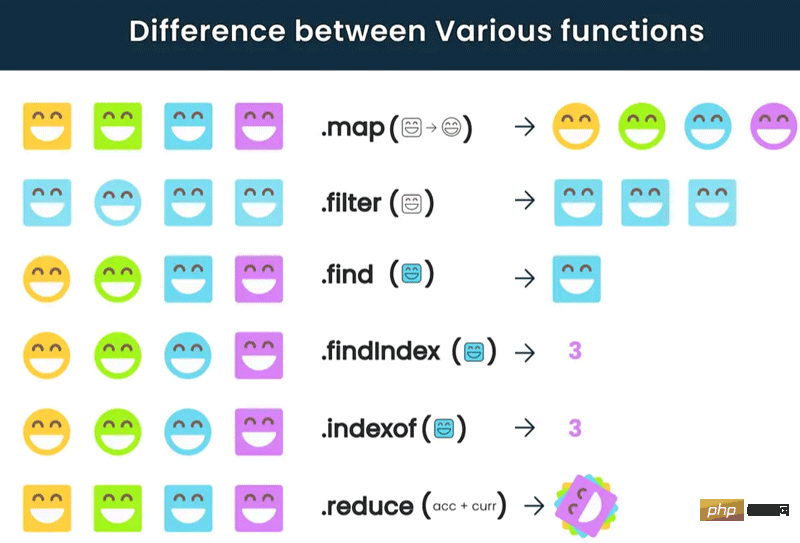9 ways to summarize JavaScript array instances
This article brings you relevant knowledge about javascript. It mainly introduces 9 methods of JavaScript array instances. The detailed introduction of the article around the topic does not have certain reference value. It is needed Friends can refer to it.

[Related recommendations: javascript video tutorial, web front-end】
Preface
Handwritten JS native API is very common in interviews. Today, while working hard (while fishing), I turned to the part about array instance methods in the MDN article. I happened to be bored, so I wrote a few instance methods by hand to review the basic content. And record it.

If you still don’t know the difference between iteration methods in array instances, you can look at the picture below:

map
This method will return a new array. Each item in the array is the result of executing the callback function provided by map.
The implementation code is as follows:
const map = (array, fun) => {
// 类型约束
if (Object.prototype.toString.call(array) !== '[object Array]')
throw new TypeError(array + ' is not a array')
if (typeof fun !== 'function') throw new TypeError(fun + ' is not a function')
// 定义一个空数组,用于存放修改后的数据
let res = []
for (let i = 0; i < array.length; i++) {
res.push(fun(array[i]))
}
return res
}
// 测试
let res = map([1, 2, 3], item => {
return item * 2
})
console.log(res) // [ 2, 4, 6 ]filter
This method will return a new array, and the values in the array satisfy filterThe value of the callback function provided,
The implementation code is as follows:
const filter = (array, fun) => {
// 类型约束
if (Object.prototype.toString.call(array) !== '[object Array]')
throw new TypeError(array + ' is not a array')
if (typeof fun !== 'function') throw new TypeError(fun + ' is not a function')
// 定义一个空数组,用于存放符合条件的数组项
let res = []
for (let i = 0; i < array.length; i++) {
// 将数组中的每一项都调用传入的函数,如果返回结果为true,则将结果push进数组,最后返回
fun(array[i]) && res.push(array[i])
}
return res
}
// 测试
let res = filter([1, 2, 3], item => {
return item > 2
})
console.log(res) // [ 3 ]some
This method will judge each item in the array, If one of the items satisfies the condition in the callback function, true is returned. If none is satisfied, false is returned.
The implementation code is as follows:
const some = (array, fun) => {
// 类型约束
if (Object.prototype.toString.call(array) !== '[object Array]')
throw new TypeError(array + ' is not a array')
if (typeof fun !== 'function') throw new TypeError(fun + ' is not a function')
let flag = false
for (let i of array) {
if (fun(i)) {
flag = true
break
}
}
return flag
}
let res = some([1, 2, 3], item => {
return item > 2
})
console.log(res) // trueevery
This method will judge each item in the array. If all items meet the conditions in the callback function, Returns true otherwise returns false.
The implementation code is as follows:
const every = (array, fun) => {
// 类型约束
if (Object.prototype.toString.call(array) !== '[object Array]')
throw new TypeError(array + ' is not a array')
if (typeof fun !== 'function') throw new TypeError(fun + ' is not a function')
let flag = true
for (let i of array) {
if (!fun(i)) {
flag = false
break
}
}
return flag
}
let res = every([1, 2, 3], item => {
return item > 0
})
console.log(res) // truereduce
This method will cause each element in the array to execute the callback function we provide, And summarize the results and return them, the implementation code is as follows:
const reduce = (array, fun, initialValue) => {
// 类型约束
if (Object.prototype.toString.call(array) !== '[object Array]')
throw new TypeError(array + ' is not a array')
if (typeof fun !== 'function') throw new TypeError(fun + ' is not a function')
let accumulator = initialValue
for (let i = 0; i < array.length; i++) {
accumulator = fun(accumulator, array[i], i, array)
}
return accumulator
}
const arr = [1, 2, 3]
console.log(arr.reduce(v => v + 10, 10)) // 40
console.log(reduce(arr, v => v + 10, 10)) // 40forEach
This method is relatively simple, it is to traverse the array method, each item in the array is executed The callback function, the implementation code is as follows:
const forEach = (array, fun) => {
// 类型约束
if (Object.prototype.toString.call(array) !== '[object Array]')
throw new TypeError(array + ' is not a array')
if (typeof fun !== 'function') throw new TypeError(fun + ' is not a function')
for (let i of array) {
fun(i)
}
}
let res = forEach([1, 2, 3], item => {
console.log(item)
})find and findIndex
These two methods are relatively similar, one returns the element and the other returns the index of the element. Here we write one , the implementation code is as follows:
const myFind = (array, fun) => {
// 类型约束
if (Object.prototype.toString.call(array) !== '[object Array]')
throw new TypeError(array + ' is not a array')
if (typeof fun !== 'function') throw new TypeError(fun + ' is not a function')
let res
for (let i = 0; i < array.length; i++) {
if (fun(array[i])) {
res = array[i]
}
}
return res
}
// 测试
let res = myFind([1, 2, 3], item => {
return item > 2
})
console.log(res) // 3join
This method can splice all elements in the array according to the specified string and return the spliced string,
The implementation code is as follows:
const join = (array, separator = ',') => {
// 类型约束
if (Object.prototype.toString.call(array) !== '[object Array]')
throw new TypeError(array + ' is not a array')
if (typeof separator !== 'string')
throw new TypeError(separator + ' is not a string')
let res = array[0].toString()
for (let i = 0; i < array.length - 1; i++) {
res += separator + array[i + 1].toString()
}
return res
}
// 测试
let res = join([1, 2, 3], '-')
console.log(res) // 1-2-3[Related recommendations: javascript video tutorial, web front-end]
The above is the detailed content of 9 ways to summarize JavaScript array instances. For more information, please follow other related articles on the PHP Chinese website!

Hot AI Tools

Undresser.AI Undress
AI-powered app for creating realistic nude photos

AI Clothes Remover
Online AI tool for removing clothes from photos.

Undress AI Tool
Undress images for free

Clothoff.io
AI clothes remover

AI Hentai Generator
Generate AI Hentai for free.

Hot Article

Hot Tools

Notepad++7.3.1
Easy-to-use and free code editor

SublimeText3 Chinese version
Chinese version, very easy to use

Zend Studio 13.0.1
Powerful PHP integrated development environment

Dreamweaver CS6
Visual web development tools

SublimeText3 Mac version
God-level code editing software (SublimeText3)

Hot Topics
 1377
1377
 52
52
 How to implement an online speech recognition system using WebSocket and JavaScript
Dec 17, 2023 pm 02:54 PM
How to implement an online speech recognition system using WebSocket and JavaScript
Dec 17, 2023 pm 02:54 PM
How to use WebSocket and JavaScript to implement an online speech recognition system Introduction: With the continuous development of technology, speech recognition technology has become an important part of the field of artificial intelligence. The online speech recognition system based on WebSocket and JavaScript has the characteristics of low latency, real-time and cross-platform, and has become a widely used solution. This article will introduce how to use WebSocket and JavaScript to implement an online speech recognition system.
 WebSocket and JavaScript: key technologies for implementing real-time monitoring systems
Dec 17, 2023 pm 05:30 PM
WebSocket and JavaScript: key technologies for implementing real-time monitoring systems
Dec 17, 2023 pm 05:30 PM
WebSocket and JavaScript: Key technologies for realizing real-time monitoring systems Introduction: With the rapid development of Internet technology, real-time monitoring systems have been widely used in various fields. One of the key technologies to achieve real-time monitoring is the combination of WebSocket and JavaScript. This article will introduce the application of WebSocket and JavaScript in real-time monitoring systems, give code examples, and explain their implementation principles in detail. 1. WebSocket technology
 How to use JavaScript and WebSocket to implement a real-time online ordering system
Dec 17, 2023 pm 12:09 PM
How to use JavaScript and WebSocket to implement a real-time online ordering system
Dec 17, 2023 pm 12:09 PM
Introduction to how to use JavaScript and WebSocket to implement a real-time online ordering system: With the popularity of the Internet and the advancement of technology, more and more restaurants have begun to provide online ordering services. In order to implement a real-time online ordering system, we can use JavaScript and WebSocket technology. WebSocket is a full-duplex communication protocol based on the TCP protocol, which can realize real-time two-way communication between the client and the server. In the real-time online ordering system, when the user selects dishes and places an order
 How to implement an online reservation system using WebSocket and JavaScript
Dec 17, 2023 am 09:39 AM
How to implement an online reservation system using WebSocket and JavaScript
Dec 17, 2023 am 09:39 AM
How to use WebSocket and JavaScript to implement an online reservation system. In today's digital era, more and more businesses and services need to provide online reservation functions. It is crucial to implement an efficient and real-time online reservation system. This article will introduce how to use WebSocket and JavaScript to implement an online reservation system, and provide specific code examples. 1. What is WebSocket? WebSocket is a full-duplex method on a single TCP connection.
 JavaScript and WebSocket: Building an efficient real-time weather forecasting system
Dec 17, 2023 pm 05:13 PM
JavaScript and WebSocket: Building an efficient real-time weather forecasting system
Dec 17, 2023 pm 05:13 PM
JavaScript and WebSocket: Building an efficient real-time weather forecast system Introduction: Today, the accuracy of weather forecasts is of great significance to daily life and decision-making. As technology develops, we can provide more accurate and reliable weather forecasts by obtaining weather data in real time. In this article, we will learn how to use JavaScript and WebSocket technology to build an efficient real-time weather forecast system. This article will demonstrate the implementation process through specific code examples. We
 Simple JavaScript Tutorial: How to Get HTTP Status Code
Jan 05, 2024 pm 06:08 PM
Simple JavaScript Tutorial: How to Get HTTP Status Code
Jan 05, 2024 pm 06:08 PM
JavaScript tutorial: How to get HTTP status code, specific code examples are required. Preface: In web development, data interaction with the server is often involved. When communicating with the server, we often need to obtain the returned HTTP status code to determine whether the operation is successful, and perform corresponding processing based on different status codes. This article will teach you how to use JavaScript to obtain HTTP status codes and provide some practical code examples. Using XMLHttpRequest
 How to use insertBefore in javascript
Nov 24, 2023 am 11:56 AM
How to use insertBefore in javascript
Nov 24, 2023 am 11:56 AM
Usage: In JavaScript, the insertBefore() method is used to insert a new node in the DOM tree. This method requires two parameters: the new node to be inserted and the reference node (that is, the node where the new node will be inserted).
 How to get HTTP status code in JavaScript the easy way
Jan 05, 2024 pm 01:37 PM
How to get HTTP status code in JavaScript the easy way
Jan 05, 2024 pm 01:37 PM
Introduction to the method of obtaining HTTP status code in JavaScript: In front-end development, we often need to deal with the interaction with the back-end interface, and HTTP status code is a very important part of it. Understanding and obtaining HTTP status codes helps us better handle the data returned by the interface. This article will introduce how to use JavaScript to obtain HTTP status codes and provide specific code examples. 1. What is HTTP status code? HTTP status code means that when the browser initiates a request to the server, the service




